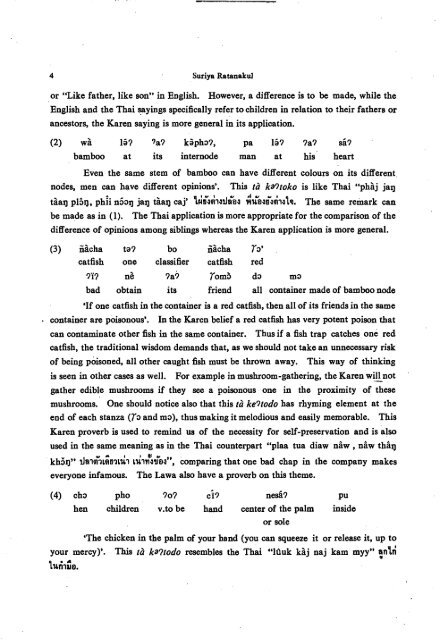The Journal of the Siam Society Vol. LXXII, Part 1-2, 1984 - Khamkoo
The Journal of the Siam Society Vol. LXXII, Part 1-2, 1984 - Khamkoo
The Journal of the Siam Society Vol. LXXII, Part 1-2, 1984 - Khamkoo
Create successful ePaper yourself
Turn your PDF publications into a flip-book with our unique Google optimized e-Paper software.
4 Suriya Ratanakul<br />
. or "Like fa<strong>the</strong>r, like son" in English. However, a difference is to be made, while <strong>the</strong><br />
English and <strong>the</strong> Thai ~ayings specifically refer to children in relation to <strong>the</strong>ir fa<strong>the</strong>rs or<br />
ancestors, <strong>the</strong> Karen saying is more general in its application.<br />
(2) wa<br />
bamboo<br />
la?<br />
at<br />
?a?<br />
its<br />
k3ph:>?,<br />
internode<br />
pa<br />
man<br />
la?<br />
at<br />
?a?<br />
his.<br />
sa?<br />
heart<br />
Even <strong>the</strong> same stem <strong>of</strong> bamboo can have different colours on its different.<br />
nodes, men can have different opinions'.<br />
This ta ka?toko is like Thai "phaj jalJ<br />
taaiJ ploiJ, phii n5:>IJ jaiJ taaiJ caj' 'l,4;,~,,1l;a, .W,ra_,;,~,,'l.~. <strong>The</strong> same remark can<br />
be made as in (1).<br />
<strong>The</strong> Thai application is more appropriate for <strong>the</strong> comparison <strong>of</strong> <strong>the</strong><br />
difference <strong>of</strong> opinions among siblings whereas <strong>the</strong> Karen application is more general.<br />
(3) iiacha ta? bo iiacha ro•<br />
catfish one classifier catfish red<br />
?'i? ne ?a? rom:> d:> m:><br />
bad obtain its friend all container made <strong>of</strong> bamboo node<br />
'If one catfish in <strong>the</strong> container is a red catfish, <strong>the</strong>n all <strong>of</strong> its friends in <strong>the</strong> same<br />
container are poisonous'. In <strong>the</strong> Karen belief a red catfish has very potent poison that<br />
can contaminate o<strong>the</strong>r fish in <strong>the</strong> same container. Thus if a fish trap catches one red<br />
catfish, <strong>the</strong> traditional wisdom demands that, as we should not take an unnecessary risk<br />
<strong>of</strong> being poisoned, all o<strong>the</strong>r caught fish must be thrown away.<br />
is seen in o<strong>the</strong>r cases as well.<br />
This way <strong>of</strong> thinking<br />
For example in mushroom-ga<strong>the</strong>ring, <strong>the</strong> Karen will not<br />
ga<strong>the</strong>r edible mushrooms if <strong>the</strong>y see a poisonous one in <strong>the</strong> proximity <strong>of</strong> <strong>the</strong>se<br />
mushrooms. One should notice also that this ta ke?todo has rhyming element at <strong>the</strong><br />
end <strong>of</strong> each stanza (ro and mo), thus making it melodious and easily memorable. This<br />
Karen proverb is used to remind us <strong>of</strong> <strong>the</strong> necessity for self-preservation and is also<br />
used in <strong>the</strong> same meaning as in <strong>the</strong> Thai counterpart "plaa tua diaw naw, naw thalJ<br />
· khoiJ" t.l"1911L;!I1L'Ii1 L,.L,.rf.,,;£1,", comparing that one bad chap in <strong>the</strong> company makes<br />
everyone infamous. <strong>The</strong> Lawa also have a proverb on this <strong>the</strong>me.<br />
(4) cho pho ?o?<br />
hen children v.to be<br />
cl?<br />
hand<br />
nesa?<br />
center <strong>of</strong> <strong>the</strong> palm<br />
or sole<br />
pu<br />
inside<br />
'<strong>The</strong> chicken in <strong>the</strong> palm <strong>of</strong> your hand (you can squeeze it or release it, up to<br />
your mercy)'. This ta ka?todo resembles <strong>the</strong> Thai "lOuk kaj naj kam myy" "n'lri<br />
'l.~rh~o.<br />
..

















